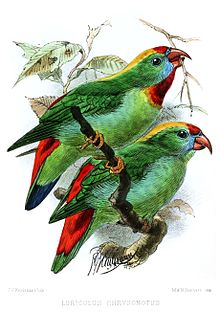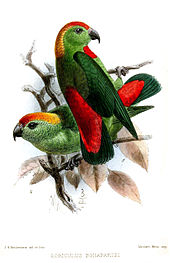- Philippine Hanging Parrot
-
Philippine Hanging Parrot 
Conservation status Scientific classification Kingdom: Animalia Phylum: Chordata Class: Aves Order: Psittaciformes Family: Psittacidae Tribe: Psittaculini Genus: Loriculus Species: L. philippensis Binomial name Loriculus philippensis
(P.L.S. Müller, 1776)The Philippine Hanging Parrot (Loriculus philippensis) is also widely known as the Colasisi[2] taken from its local Tagalog name, "Kulasisi". It is a small parrot species of the Psittacidae family. It includes about eleven subspecies, which are all native to only the Philippines; however, the exact taxonomy is unclear, and at least one of the subspecies might become split off and become a separate species if further research provides clarification.
They are mainly green with areas of red, orange, yellow, and blue varying between subspecies. Only the males have a red area on their fronts, except for the population living on Camiguin, where neither male nor female have this red area. They make nests in tree holes and, unusually for a parrot, the female takes nesting material back to the nest.
Contents
Description
Philippine Hanging Parrots are about 14 cm (5.5 in) long, weigh 32–40 g, and have a short rounded tail.[3] They are mainly green with areas of red, orange, yellow, and blue varying between subspecies.[3] The forehead is red and the irises are dark brown.[4] Adults have red beaks and orange legs except for Loriculus (philippensis) bonapartei which have black beaks and grey legs.[3] They are sexually dimorphic with only the males having red on their chin or upper chest,[3][4] except for the Loriculus (philippensis) camiguinensis in which neither the male or female has a red bib or chest.[5] Juveniles have less red on their heads and paler beaks, but otherwise resemble the female.[3][4]
Taxonomy
The species or species complex was initially described by Statius Müller in 1776. The exact taxonomy listing is unclear.[3][5][6]
Loriculus philippensis (Statius Muller) 1776
- Loriculus philippensis apicalis Souance 1856
- Loriculus (philippensis) bonapartei Souance 1856[3] (Black-billed Hanging Parrot)
- Loriculus philippensis bournsi McGregor 1905
- Loriculus philippensis chrysonotus Sclater, PL 1872 (Cebu Hanging Parrot)
- Loriculus philippensis dohertyi Hartert 1906
- Loriculus philippensis mindorensis Steere 1890
- Loriculus philippensis philippensis (Statius Muller) 1776
- Loriculus philippensis regulus Souance 1856
- Loriculus philippensis siquijorensis Steere 1890
- Loriculus philippensis worcesteri Steere 1890
- Loriculus (philippensis) camiguinensis Tello, JG 2006[5] (Camiguin Hanging Parrot)
In 2006, hanging parrots living on the island of Camiguin, off the northern coast of Mindanao, were described and thought to have a separate identity, Loriculus (philippensis) camiguinensis; however, more research and DNA analysis is required to clarify their taxonomy.[1][5] There is also uncertainty over the taxonomy of Loriculus (philippensis) bonapartei which has been classified as a subspecies or a species in different classifications.[3]
Distribution and habitat
The Philippine Hanging Parrot is native to the Philippines except the Sulu Archipelago and it is not widespread on Palawan. The different subspecies are native to different islands, and some subspecies are rare or almost extinct. Trading of birds between the islands for pets has resulted in escaped pets living on different islands to where they originated.[4]
Its natural habitats are tropical moist lowland forests, bamboo forest and tropical moist montane forest. It also occupies human-modified habitats including coconut groves and secondary forest. It is most common in lowland areas, being rare above 1250 m.[7]
Behaviour and ecology
 A male L. p. philippensis eating fruit at Subic Bay, Luzon, Philippines.
A male L. p. philippensis eating fruit at Subic Bay, Luzon, Philippines.
Philippine Hanging Parrots are usually encountered alone or in pairs, rarely in small groups.[8] They mostly forage for food in the canopy or middle storeys of forests,[8] and their diet is composed of nectar and flowers as well as soft fruits such as those from figs (Ficus).[7]
The species is a season breeder, with nesting occurring from March to May. Like most parrots it is a cavity nester; a nest found in the wild was in a cavity high up in a dead tree. However, it is one of the few species of parrots that uses nesting material in the nest, the female tucks nesting material between feathers in order to take it back to the nest.[4] In captivity the clutch size was 3 eggs which are incubated for 20 days. The chicks take around 35 days to fledge after hatching.[4][7] The rounded eggs measure about 18.7 x 16.4 mm.[8]
References
- ^ a b BirdLife International 2008. Loriculus philippensis. 2008 IUCN Red List of Threatened Species.
- ^ Kennedy, R.S., Gonzales P.C., Dickinson E.C., Miranda, Jr, H.C., Fisher T.H. (2000) A Guide to the Birds of the Philippines, Oxford University Press, Oxford.
- ^ a b c d e f g h Forshaw, Joseph M. (2006). Parrots of the World; an Identification Guide. Illustrated by Frank Knight. Princeton University Press. plate 46. ISBN 0691092516.
- ^ a b c d e f Juniper, Tony; Mike Parr (1998). "182 Colasisi". Parrots: A Guide to Parrots of the World. Yale University Press. ISBN 978-0300074536.
- ^ a b c d Arndt, Thomas (2006). "A new hanging parrot from Camiguin Island, Philippines". BirdingASIA 5: 55–58. http://www.orientalbirdclub.org/publications/ba5pdfs/camiguinparrotpdf.pdf.
- ^ "Zoological Nomenclature Resource: Psittaciformes (Version 9.022)". www.zoonomen.net. 2009-03-01. http://www.zoonomen.net/avtax/psit.html.
- ^ a b c Collar N (1997) "Family Psittacidae (Parrots)" in Handbook of the Birds of the World Volume 4; Sandgrouse to Cuckoos (eds del Hoyo J, Elliott A, Sargatal J) Lynx Edicions:Barcelona. P. 405 ISBN 84-87334-22-9
- ^ a b c Forshaw, Joseph M.; Cooper, William T. (1981) [1973, 1978]. Parrots of the World (corrected second ed.). David & Charles, Newton Abbot, London. pp. 326–27. ISBN 0-7153-7698-5.
- Tello, J.G., Degner, J.F., Bates, J.M. & Willard, D.E. 2006. A new species of hanging-parrot (Aves: Psittacidae: Loriculus) from Camiguin Island, Philippines. Fieldiana Zoology 106:49-57.
External links
- Philippine Hanging-parrot - BirdLife Species Factsheet, BirdLife International, 2008, http://www.birdlife.org/datazone/species/index.html?action=SpcHTMDetails.asp&sid=1517&m=0
- Oriental Bird Images: Philippine Hanging Parrot Selected photos
Tribus: Psittaculini Genus Species (taxonomy note: * Réunion Parakeet and Mauritius Parakeet may united as subspecies or split as separate species)
(extinctions: † indicates a species confirmed to be extinct, ₴ indicates evidence only from sub-fossils)Psittinus Psittacella Brehm's Tiger Parrot • Painted Tiger Parrot • Modest Tiger Parrot • Madarasz's Tiger ParrotGeoffroyus Red-cheeked Parrot (or Singing Parrot) • Blue-collared Parrot • Song ParrotPrioniturus Montane Racket-tail • Mindanao Racket-tail • Blue-headed Racket-tail • Green Racket-tail • Blue-crowned Racket-tail • Blue-winged Racket-tail (or Sulu Racket-tail) • Yellow-breasted Racket-tail • Golden-mantled Racket-tail • Buru Racket-tailTanygnathus Eclectus Alisterus Aprosmictus Jonquil Parrot (or Olive-shouldered Parrot) • Red-winged ParrotPolytelis Psittacula Alexandrine Parakeet (or Alexandrine Parrot) • Seychelles Parakeet † • Rose-ringed Parakeet (or Ringnecked Parakeet) • Réunion Parakeet † * • Mauritius Parakeet * • Newton's Parakeet † • Slaty-headed Parakeet • Grey-headed Parakeet • Plum-headed Parakeet • Blossom-headed Parakeet • Lord Derby's Parakeet • Red-breasted Parakeet • Nicobar Parakeet • Long-tailed ParakeetLoriculus Vernal Hanging Parrot • Sri Lanka Hanging Parrot • Philippine Hanging Parrot (supporting pages: Cebu Hanging Parrot and Camiguin Hanging Parrot) • Blue-crowned Hanging Parrot • Great Hanging Parrot (or Sulawesi Hanging Parrot) • Sula Hanging Parrot • Moluccan Hanging Parrot • Sangihe Hanging Parrot • Orange-fronted Hanging Parrot (or Papuan Hanging Parrot) • Bismarck Hanging Parrot (or Green-fronted Hanging Parrot • Pygmy Hanging Parrot (or Red-billed Hanging Parrot) • Yellow-throated Hanging Parrot • Wallace's Hanging Parrot • Camiguin Hanging ParrotAgapornis Rosy-faced Lovebird (supporting page: Rosy-faced Lovebird colour genetics) • Yellow-collared Lovebird (or Masked Lovebird ) • Fischer's Lovebird • Lilian's Lovebird • Black-cheeked Lovebird • Grey-headed Lovebird (or Madagascar Lovebird) • Black-winged Lovebird (or Abyssinian Lovebird) • Red-headed Lovebird (or Red-faced Lovebird) • Black-collared Lovebirdincertae sedis
(probably Psittaculini)Mascarene Parrot † (genus: Mascarinus) • Broad-billed Parrot † (genus: Lophopsittacus) • Rodrigues Parrot † (genus: Necropsittacus)Categories:- IUCN Red List least concern species
- Psittaculini
- Loriculus
- Birds of the Philippines
Wikimedia Foundation. 2010.


